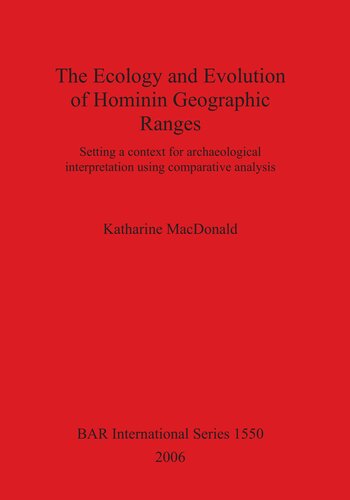

Most ebook files are in PDF format, so you can easily read them using various software such as Foxit Reader or directly on the Google Chrome browser.
Some ebook files are released by publishers in other formats such as .awz, .mobi, .epub, .fb2, etc. You may need to install specific software to read these formats on mobile/PC, such as Calibre.
Please read the tutorial at this link: https://ebookbell.com/faq
We offer FREE conversion to the popular formats you request; however, this may take some time. Therefore, right after payment, please email us, and we will try to provide the service as quickly as possible.
For some exceptional file formats or broken links (if any), please refrain from opening any disputes. Instead, email us first, and we will try to assist within a maximum of 6 hours.
EbookBell Team

4.8
54 reviewsIn this work the author uses an evolutionary and ecological approach to interpreting early hominin geographic ranges, specifically integrating theory from biogeography and studies of human evolution. A key part of the research is a comparative study of primate distribution in relation to physical and behavioural characteristics and environmental factors using GIS and statistical techniques. The comparative method makes it possible to test hypotheses of adaptation and correlated evolution of environmental tolerance, geographical distribution, and certain key behavioural characteristics. The breadth of data available from studies of extant primates makes it possible to analyse the role of a range of behavioural and life history characteristics in the evolution of primate geographic ranges. Contents: Chapter 1 is an introduction and Chapter 2 presents a survey of the literature on the modern distribution of species, to determine which factors have been identified as important and how they interact. Chapter 3 outlines changes in early hominin geographic ranges over time, giving three models of the evolution of hominin geographic ranges. These models are based on theories about human evolution, and the spatial processes described in Chapter 2, and are backed up where possible with examples of trends in the fossil record. Chapter 4 describes a comparative analysis of primate distribution in relation to physical and behavioural characteristics and environmental factors, conducted using GIS and statistical techniques – with a particularly focus on the interaction of the factors such as: behavioural flexibility and cultural transmission, geographical distribution and environmental variability, and life history parameters. Chapter 5 is an investigation of large-scale patterns in the distribution and ecology of modern African mammals. The aim is to assess the role of dietary niches, particularly meat eating, in species distribution. Chapter 6 assesses the relevance of the models developed through theoretical discussion and comparative analysis, by examining the data on early hominin distribution and ecological niches for a particular case study. The chapter also looks at hypotheses of hominin range expansion during the period 1.8-0.6 million years ago in Africa, by comparing palaeoanthropological and archaeological data with the predictions of the models.